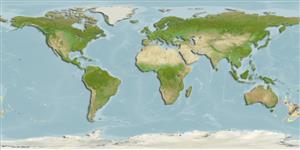Klassifizierung / Names
Namen | Synonyme | Catalog of Fishes(Gattung, Arten) | ITIS | CoL | WoRMS | Cloffa
Elasmobranchii (Haie und Rochen) (sharks and rays) >
Squaliformes (Sleeper and dogfish sharks) >
Squalidae (Dogfish sharks)
Etymology: Squalus: Genus name from Latin 'squalus' meaning shark (Ref. 6885, 27436); chloroculus: Name from Greek 'choloros' for green and Latin 'oculus' for eye, referring to the vivid green eyes of this species when fresh..
More on authors: Last, White & Motomura.
Environment: milieu / climate zone / depth range / distribution range
Ökologie
seewasser bathydemersal; tiefenbereich 213 - 1360 m (Ref. 58441). Deep-water
Western Pacific: Australia.
Length at first maturity / Size / Gewicht / Alter
Maturity: Lm 79.9 range ? - ? cm
Max length : 85.6 cm TL Männchen/unbestimmt; (Ref. 58441); 99.0 cm TL (female)
Kurzbeschreibung
Morphologie | Morphometrie
This species of the ‘mitsukurii group’ is large and is distinguished by the following set of characters: body moderately robust, trunk depth 10.4-13.8% TL (mean 11.7% TL, n=9); snout is broadly triangular, with mouth width 1.72-2.48 (2.07) times the horizontal prenarial length; pre-first dorsal length 29.2-31.8 (30.2)% TL; pre-second dorsal length 60.7-63.6 (61.7)% TL; interdorsal space 23.7-27.5 (24.9)% TL; low raked dorsal fins; second dorsal-fin length 10.9-12.2 (11.6)% TL, height 3.4-4.0 (3.7)% TL, inner margin length 3.9-5.0 (4.4)% TL; second dorsal-fin base 15.1-20.0 (17.2) times the base of second dorsal spine; pre-pectoral length 21.1-24.3 (22.2)% TL; pelvic-caudal space 21.8-25.0 (23.5)% TL; caudal bar is almost upright, extending broadly from the caudal fork up the poster or margin of the upper lobe for 0.6-0.7 of its length in immature individuals, upper caudal fringe forming a narrow saddle along midlength of lobe; flank denticles tricuspid; monospondylous centra 43-46, precaudal centra 84-86, total centra 111-115 (Ref. 58441).
Distinct pairing with embrace (Ref. 205).
Last, P.R., W.T. White and H. Motomura, 2007. Description of Squalus chloroculus sp. nov., a new spurdog from southern Australia, and the resurrection of S. montalbani Whitley. p. 55-69. In P.R. Last, W.T. White and J.J. Pogonoski Descriptions of new dogfishes of the genus Squalus (Squaloidea:Squalidae). CSIRO Marine and Atmospheric Research Paper No. 014. 130 p. (Ref. 58441)
IUCN Rote Liste Status (Ref. 130435)
Bedrohung für Menschen
Harmless
Nutzung durch Menschen
Mehr Information
Alter/GrößeWachstumLänge-GewichtLänge-LängeLängenhäufigkeitenMorphometrieMorphologieLarvenLarven Pop.Dyn.RekrutierungDichteBRUVS
ReferenzenAquakulturAquakultur ProfilZuchtlinienGenetikElectrophoresesVererbbarkeitKrankheitenVerarbeitungNutrientsMass conversion
PartnerBilderStamps, Coins Misc.LauteCiguateraGeschwindigkeitSchwimmstilKiemenoberflächeOtolithsGehirngrößeSehfähigkeit
Tools
Zusatzinformationen
Download XML
Internet Quellen
Estimates based on models
Preferred temperature (Ref.
123201): 5.9 - 11.4, mean 8.5 °C (based on 45 cells).
Phylogenetic diversity index (Ref.
82804): PD
50 = 0.5000 [Uniqueness, from 0.5 = low to 2.0 = high].
Bayesian length-weight: a=0.00339 (0.00162 - 0.00707), b=3.10 (2.93 - 3.27), in cm total length, based on LWR estimates for this Genus-body shape (Ref.
93245).
Trophic level (Ref.
69278): 4.4 ±0.4 se; based on size and trophs of closest relatives
Widerstandsfähigkeit (Ref.
120179): sehr niedrig, Verdopplung der Population dauert mehr als 14 Jahre. (Fec=4-15).
Fishing Vulnerability (Ref.
59153): High vulnerability (60 of 100).
